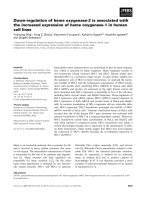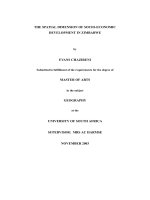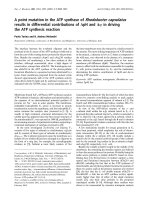The geological controls of geothermal groundwater sources in Lebanon
Bạn đang xem bản rút gọn của tài liệu. Xem và tải ngay bản đầy đủ của tài liệu tại đây (537.71 KB, 10 trang )
I
NTERNATIONAL
J
OURNAL OF
E
NERGY AND
E
NVIRONMENT
Volume 4, Issue 5, 2013 pp.787-796
Journal homepage: www.IJEE.IEEFoundation.org
ISSN 2076-2895 (Print), ISSN 2076-2909 (Online) ©2013 International Energy & Environment Foundation. All rights reserved.
The geological controls of geothermal groundwater sources
in Lebanon
Amin Shaban
1
, Layla Khalaf-Keyrouz
2
1
National Council for Scientific Research, Remote Sensing Center, Beirut, Lebanon.
2
Notre Dame University-Louaize, Zouk Mosbeh, Lebanon.
Abstract
Lebanon is a country that is relatively rich in water resources, as compared to its neighboring states in the
Middle East. Several water sources are issuing on the surface or subsurface, including nonconventional
water sources as the geothermal groundwater. This aspect of water sources exists in Lebanon in several
localities, as springs or in deep boreholes. To the present little attention has been given to these resources
and their geological setting is still unidentified. The preliminary geological field surveys revealed that
they mainly occur in the vicinity of the basalt outcrops. Therefore, understanding their geological
controls will help in exploring their origin, and thus giving insights into their economical exploitation.
This can be investigated by applying advanced detection techniques, field surveys along with detailed
geochemical analysis. This study aims at assessing the geographic distribution of the geothermal water in
Lebanon with respect to the different geological settings and controls that govern their hydrogeologic
regimes. It will introduce an approach for an integrated water resources management which became of
utmost significance for the country.
Copyright © 2013 International Energy and Environment Foundation - All rights reserved.
Keywords: Hot water; Basalt; Renewable energy; Thermal detection; Lebanon.
1. Introduction
Water resources occur in different aspects and dimensions, which implies multiple uses. Water for
domestic use is the most important, seconded by irrigation, which is a supplementary exploitation for
human needs. The miscellany of other uses, as industrial and recreational, depends on the water quality
and available supply. Warm water, also referred to as “geothermal water” is another feature of
groundwater. It exists in several regions in the world, where it is exploited for different purposes, mainly
energy. The American Energy Commission [1] estimated that geothermal resources can supply the
world’s need of energy for the next 100000 years. While, the New Energy Foundation [2] reported the
increasing implementation of the geothermal resources in the generation of electricity: Japan relies on 16
geothermal power plants with approximately 530 MW production, covering 0.2% of its power capacity.
At present, 24 countries generate electricity from geothermal resources, among which the leading five are
USA, Philippines, Indonesia, Mexico and Italy [3].
The geothermal heat pumps currently occupy up to approximately ¾ of the total installed capacity use.
Other uses, by decreasing order, include bathing and swimming, space heating, greenhouse heating,
aquaculture pond heating, cooling/snow melting and agricultural drying [4]. Kenya, as an example relies
on geothermal energy for greenhouses heating, warming swimming pools, and drying pyrethrum
International Journal of Energy and Environment (IJEE), Volume 4, Issue 5, 2013, pp.787-796
ISSN 2076-2895 (Print), ISSN 2076-2909 (Online) ©2013 International Energy & Environment Foundation. All rights reserved.
788
products among other beneficial uses [5]. Therefore, the exploitation of geothermal water can be of
considerable economical value. This allows for a variety of applications, owing to the wide array of
temperatures that it can have ranging from room temperature to over 300°C.
The majority of geothermal waters fall into two major categories: The hot (or warm) groundwater, and
the hot springs. Both have almost the similar hydrogeological mechanism (e.g. contact with igneous
bodies, flow regime and storage), they differ however, mainly in the volume of water reserve and the
discharge continuity. In this respect hot groundwater can be used for electrical power generation and
considered almost as an alternative energy source [6]. While, hot springs can be exploited for medical
purposes as recreational and touristic resorts, as in Slovenia, Tunisia, Iceland and Japan.
The temperature of geothermal water increases as the depth of burial of groundwater reservoir (i.e.
aquifers) increases, due to the geothermal gradient, which is a natural increase in the temperature with
depth. Hence, it is utmost important to understand the hydrgeological setting and the related geological
controls of the hot groundwater reservoirs, which is the scope of this study. This will help exploring the
geothermal water, which has a different concept than the exploration of fresh groundwater, and thus it
considers the fractures in igneous rocks with high temperature [7]. Accordingly, the exploitation
procedure implies drilling wells into the rocks, and thus penetrating the reservoirs of the temperate rocks.
The chemistry of the geothermal water differs significantly than fresh water as it contains large
concentrations of dissolved minerals, such as sodium, calcium, sulfate, chloride, or iron. These ions have
been dissolved from the minerals in rocks that compose the geothermal reservoirs and vary as the
mineral composition of the rocks varies. Especially aggressive, are hot water from volcanically active
regions, these brines contain carbonic acid, hydrogen sulfide, salts and heavy metals, which renders them
very corrosive to well casing and toxic due to the waste water, besides emissions of hydrogen sulfide and
to a lesser extent carbon dioxide [8]. This necessitates detailed geochemical analysis of the waters in
question.
In Lebanon, the country with abundant freshwater resources, there are several evidences on the existence
of hot water, either as hot springs or in aquifers at depth. Nevertheless, they were discovered
unintentionally, at sites where the water flowed naturally to the surface. These geothermal water sources
occur in, or at proximity of the basaltic rocks. Yet, no proper attention has been given to these sources,
either in terms of investigating their hydrological mechanism, or investment projects.
Lebanon is considered as an energy dependent country, where oil products are still the principal sources.
They comprise about 93.5% of energy sources [9]. Lebanon imports around $500 million worth of fuel
annually to generate the electricity needs [10]. This shows the urgent need for alternative sources of
energy, as being optimized recently for the exploration of oil and gas in Lebanon. Therefore, if the
geothermal water is properly investigated, it might however fulfill an integral part of the energy needed.
There are few previous studies on the geothermal water in Lebanon, these are rather prospects and
hypothesis on the subject, such as those by [6, 10, 11]; in addition there are limited researches by
graduate students. In order however, to assess the geothermal water of Lebanon, the studies must be
performed at different institutional levels. Amongst which, an accurate understanding of the geological
setting of the geothermal water, chemical analysis for this nonconventional water, as well as the
advanced exploration techniques (e.g. remote sensing).
This study focuses on diagnosing the geological setting, and more certainly the controls of the issuing
water from the hot sources in Lebanon. It also presents a systematic approach to delineate the geothermal
potentials.
2. Aspects of geothermal water
2.1 Geology of geothermal water
Geothermal water often flows, discharges and is stored in almost similar hydrogeological regimes similar
to freshwater, except that it must be in a direct or indirect contact with igneous rock masses at different
depths and aspects of contact. Thus, geothermal waters can be issuing on the surface as springs or
seepages, and they can be also subsurface sources such as the case in deep groundwater. Therefore, the
geology of geothermal water along with the controlling factors should be well identified. This will help
estimating the regime of discharge, the chemistry and the sustainability of the resource.
Heating groundwater follows different hydrologic mechanisms, therefore presenting numerous aspects.
The main ones can be described as follows:
International Journal of Energy and Environment (IJEE), Volume 4, Issue 5, 2013, pp.787-796
ISSN 2076-2895 (Print), ISSN 2076-2909 (Online) ©2013 International Energy & Environment Foundation. All rights reserved.
789
1. Direct contact between deep groundwater and hot magmatic rocks where molten materials heat up the
water which is mostly stored at considerable depth in the confined aquifers (Figure 1a). This
groundwater usually has high temperatures that may exceed 300°C.
2. Contact between the sedimentary aquifers and hot igneous rock bodies. This is well pronounced in
porous and permeable sedimentary lithologies which overly hot igneous rocks (Figure 1b). The
temperature of this groundwater is almost moderate and may reach 150-200°C; however, this mainly
depends on several influencing factors, such as the proximity to the sources of heat.
3. Flowing of geothermal water under the effect of pressure and heat, along fracture systems and
conduits, which are connected with molten materials or hot igneous bodies and open at unidentified
spots where the geothermal water discharges as springs or seepages (Figures 1c and 1d). The
temperature of this geothermal water is usually moderate to low and it does not normally exceed
100°C.
4. Dissipating hot gases along fractures and conduits, similar to geothermal water that circulates along
fractures, but the flow is mostly hot steam (i.e. gas). This setting is observed not only on-land but also
in the sea floor (Figures 1c and 1d).
Figure 1. Examples on the flow mechanism of geothermal water
Accordingly, the hydrologic mechanisms and the resulting aspects imply a number of geologic factors
that govern the dimensions, water temperature and quality of the geothermal water. The proximity of
contact between the molten materials or the hot rock masses with respect to groundwater is equally a
determining factor. These settings also control the flow regime of hot water among different lithologies,
whether in lateral or vertical directions. Therefore, in the presence of heat sources, the majority of these
factors can be summarized as follows:
1. Geologic structures: This almost includes the linear rock breaks of different sets. It can be as fissures,
joints, conduits and faults which connect the heat source to the water-bearing stratum or water outlet
localities. The geothermal water can move according to the predominant alignments of these breaks.
In the presence of fissures and joints, the hot water flows with low energy for relatively limited
distances. Nevertheless, along fault alignments, the water is transported for long distances with high
energy.
International Journal of Energy and Environment (IJEE), Volume 4, Issue 5, 2013, pp.787-796
ISSN 2076-2895 (Print), ISSN 2076-2909 (Online) ©2013 International Energy & Environment Foundation. All rights reserved.
790
This factor has a variety of aspects and dimensions which play a role in the occurrence of geothermal
water on the surface or subsurface. For example, fissures can expose geothermal water on the land
surface as patches of seeping hot water; faults almost result in hot springs with remarkable flow, but at a
unique locality; grabens, on the other hand, result in multiple sources, once the hot water sources exists.
2. Volcanic exposures: This represents the major component of geothermal water factors. The volcanic
rocks on the land surface are usually connected with subsurface and hidden igneous rock masses,
which in principle have hydrologic linkages with deep heat sources, such as magma and molten
materials.
3. Heat proximity: The closer to the magma source the more probable is the connection with heat
channels and contacts.
The volcanic rocks in contact with magma and molten materials will convey the heat through these rocks
and then to the overlying sedimentary sequences. But if these sources are at considerable depth, the heat
will not be effective in producing geothermal sources.
4. Rock boundaries: The rock boundaries might play a negative role in transporting hot water or heat in
case these boundaries (i.e. stratigraphic contacts) are wide enough to separate the vertical heat and
water flow, the heat/water can though be conveyed in lateral directions.
5. Rock mineralogy: Normally the mineralogy of the rocks has an essential role in transporting heat,
notably when the contact is directly with igneous rock. Thus, the included minerals can either act in
transporting or blocking the heat flow. For example, rocks with high metallic minerals (e.g. iron,
copper, etc) have higher heat connectivity than the non-metallic ones (e.g. silicates, etc).
6. Rock permeability: As a major physical property the permeability of rocks is the major factor in
controlling the heat and liquid flows through the different rock types. Consequently, impermeable
rocks usually act as cap rocks that reserve heat and water flow. Hence, in the case of geothermal
water, these rocks almost confine the water at depth.
7. Igneous activity: It represents the generating factor of geothermal water sources. Nevertheless, many
igneous rocks are not molten enough to produce heat and this usually depends on the thickness of the
rock masses as well as the mobilization, activity and energy of the molten materials.
2.2 Geothermal water sources in Lebanon
Indicators of geothermal sources are well known in Lebanon. They can be related to geologic evidences
(i.e. geologic structures and lithologies). Otherwise they are spotted as hot/or warm water sources and
sometimes hot gas vents.
The geologic indicators do not assure that the geothermal waters occur, whilst hot and warm waters are
direct evidence for these sources. In Lebanon, several geological evidences are correlated with the
geothermal sources. These include the volcanic rocks as basalts and tuff materials, outcropping at
different levels of the geological sequence [12]. In fact, most geothermal waters and vents found in
Lebanon are in the proximity of these rocks. In addition, there are many surface ring geomorphologic
features that are attributed to geothermal sources, where volcanic bodies exist or might have erupted in
the geologic past [13].
The geothermal water and vents in Lebanon are however the concrete evidence of the geothermal sources
existence, and since they occur where igneous bodies are located, it can be anticipated that other potential
sources might exist in other localities, in the vicinity of volcanic rocks exposures. The spotted sources
occur as surface water or are drilled in a subsurface stratum, yet they are both of groundwater origin.
They can be classified as:
2.2.1 Surface geothermal sources
These sources appear as issuing springs and seeps on the land surface, specifically where basalt rocks
occur. The hot/or warm water discharges almost at low rates (i.e. <1l/sec) and at relatively low
temperatures. A number of these springs and seeps are known in Akkar region, north Lebanon, where as
anticipated, there are several exposures of basaltic rock in the mountainous areas. However, many of
them have dried up lately as a result of the overexploitation of the groundwater reservoirs. Moreover, due
to the lack of awareness on the importance of these sources, many are not protected. They are on the
contrary covered by soil and wastes.
Ayoun es-Samak is the most known hot spring in this region. It is located at the geographic coordinates:
34°37'05" N& 35°57'59" E (Figure 2). The discharges are more than 1l/sec on average. The Field tests
show average temperatures ranging between 50-65 °C depending on the time period; higher temperatures
International Journal of Energy and Environment (IJEE), Volume 4, Issue 5, 2013, pp.787-796
ISSN 2076-2895 (Print), ISSN 2076-2909 (Online) ©2013 International Energy & Environment Foundation. All rights reserved.
791
and low discharges occur in the dry seasons [7]. The estimated Total Dissolved Solids (TDS) in the
spring was about 21000mg/kg and with pH of 8.3.
Based on the controlling geological factors, some water springs and gases have been detected in the
marine environment. These geothermal sources are well known to the fishermen along the Lebanese
coastal zone. They are clearly identified in three localities as follows:
- Along the southern coast beside Sour at the geographic coordinates: 33°15'33" N & 35°11'32"E (Figure
2). It is represented by several submarine hot vents in the sea floor at a distance of about 300 m from the
coast and at a depth of about 30m. These vents are originated from holes in the seafloor (Figure 3).
- Beside Chekka area along the northern coast at the geographic coordinates: 34°19'24" N & 35°43'21"E
(Figure 2). This site is represented by a number of small bubbles and vents of tens of centimeters in
diameter. They were detected during an airborne Thermal Infrared survey applied by [14]. The
temperature of these clusters was about 38°C while the surrounding temperature of water was about
26°C. The estimated TDS was about 18500mg/kg and with pH of 7.7.
- Facing Al-Abdeh city along the upper northern coast of Lebanon at the geographic coordinates:
34°31'37" N & 35°59'07"E (Figure 2). This spot equally exists as a number of small bubbles of warm
water, identified by the airborne Thermal Infrared survey carried out by [14]. The temperature of these
clusters was about 38°C while the surrounding temperature of water was about 22.5°C.
Figure 2. Localities of geothermal sources in Lebanon









